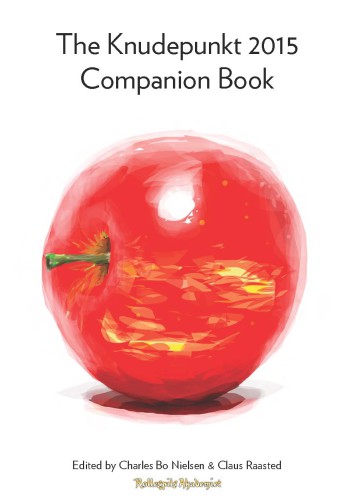This year’s Knudepunkt larp conference saw the publication of two books, first the Nordic larp yearbook 2014 and now a collection of articles about larp, the scene, game design, and other related matters. Edited by Charles Bo Nielsen and Claus Raasted, it’s called The Knudepunkt 2015 Companion Book, and you can download it here as a free PDF.
Introducing new concepts and terminology is one of this year’s book’s themes. Steering is one of these concepts, and it means consciously directing your game experience towards some kind of a goal for other than in-game reasons. Trying to kill the king because my character hates the king is not steering. Trying to kill the king because I want to get killed in a glorious death scene is steering.
The two articles about this idea are one of the highlights of the book. Markus Montola, Jaakko Stenros and Eleanor Saitta outline the idea in their article The Art of Steering. Mike Pohjola gives it personal weight in his excellent essay Steering for Immersion in Five Nordic Larps. He writes about his personal experiences steering towards certain kinds of play.
I have an article in the book about documentation and questions of private and public play. Jamie MacDonald writes about similar subjects in a more comprehensive way in his article On Publicity and Privacy, using data from a survey on the subject of larp documentation.
Another strong theme in the book is a sense of history: We’re finally old enough to have some perspective. This shows in many different ways. Myriel Balzer’s article about edularp is not about using larp to teach; it’s about teaching people how to use larp to teach.
Eirik Fatland and Markus Montola have a wonderful article called The Blockbuster Formula, analyzing the design of recent games like The Monitor Celestra and The College of Wizardry. It goes through some classic methods of larp design, and how these are updated and complemented by new ideas. It finally rehabilitates some old school ideas of design for a new era of Nordic larp.
The practical and the political intersect with design in an article by Kaisa Kangas called Processing Political Larps. She writes about political games, and talks about the challenges you can have debriefing them, as seen in the larp Halat hisar, on which I also worked.
This year’s book is a fast read, and you can get into some really interesting ideas and concepts in an afternoon. Short is sweet. However, perhaps next year we’d be ready to read some longer essays along with the shorter pieces?
